Measurements
I managed to do measurements today. Bit windy, in fact I found out that both the Seas and HiVi K1 can be dropped safely from 2m
This is a compilation of ungated, unsmoothed on and off-axis response. My yard is about 10m from the nearest wall, but I was able to raise the speaker about 2m high.
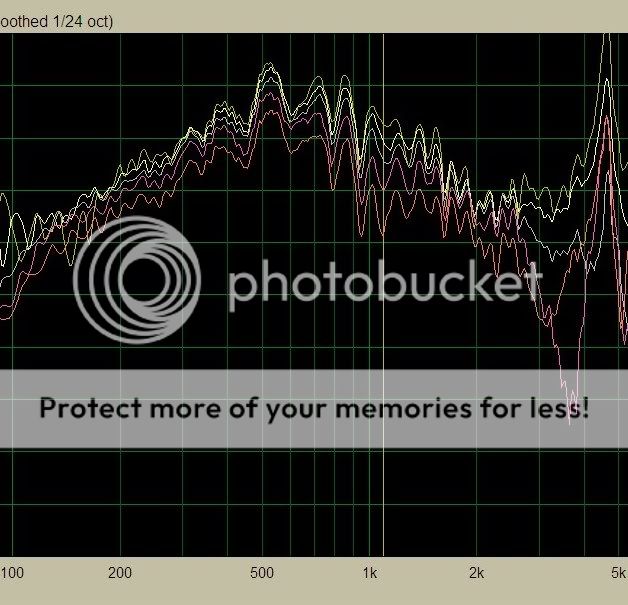
Aside from the expected -6db drop and dipole peak at about 500-600hz, the directivity narrows from 600-1.5khz, but then it actually widens. After which things fall apart at 2.5kHz. This is great because I cross at 1.5kHz.
Compiling the data further, we can see on and off-axis response is very smooth at until 2.5kHz. There is a minor appearance of peak at the extreme off-axis measurement at around 1.2khz. Note that this is differential graph, not absolute spl.
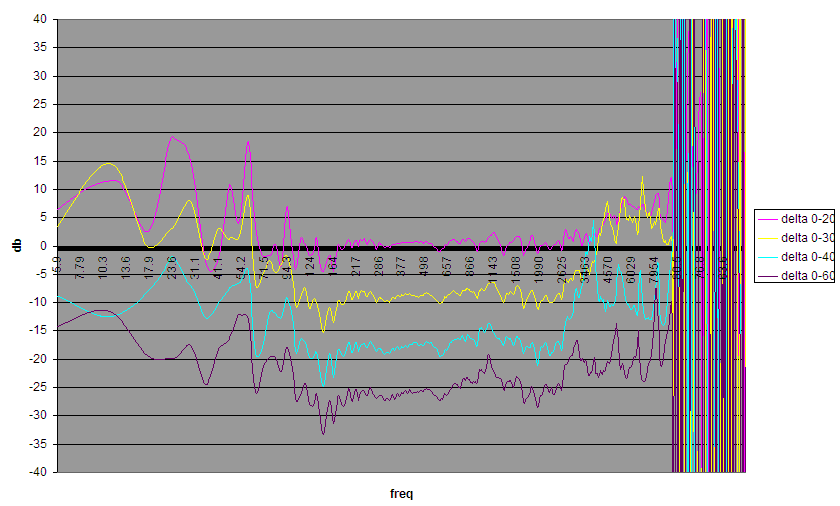
It may help to explain my observation why the sound is similiar to the previous build (S9).
I managed to do measurements today. Bit windy, in fact I found out that both the Seas and HiVi K1 can be dropped safely from 2m
This is a compilation of ungated, unsmoothed on and off-axis response. My yard is about 10m from the nearest wall, but I was able to raise the speaker about 2m high.

Aside from the expected -6db drop and dipole peak at about 500-600hz, the directivity narrows from 600-1.5khz, but then it actually widens. After which things fall apart at 2.5kHz. This is great because I cross at 1.5kHz.
Compiling the data further, we can see on and off-axis response is very smooth at until 2.5kHz. There is a minor appearance of peak at the extreme off-axis measurement at around 1.2khz. Note that this is differential graph, not absolute spl.

It may help to explain my observation why the sound is similiar to the previous build (S9).
Impressive performance up to 2.5 kHz!Compiling the data further, we can see on and off-axis response is very smooth at until 2.5kHz. There is a minor appearance of peak at the extreme off-axis measurement at around 1.2khz.

WRT the 1.2 kHz peak: This could well be some (basket) resonance reaching around from the back. You could verify this if measurements at 90° or more show that peak too - and at an increased level.
I don't say that eliminating such a resonance peak (if it exists) will make much audible difference - just another step to perfection.
Rudolf
A photo.. finally....

I've thought about 3-way, but with OB the complexity is exponential, not only the circuit/added amplifiere requirements but also acoustic such as the different physical baffle requirements.
The "peak" at 1.2khz is not actually a peak. The graph is differential graph so that peak refers to frequency response dropping more than they should compared to the lesser angles (The smaller P13, instead, have 1.5khz peak due to some energy storage issue as can be seen in the datasheet).
Below is a smoothed graph to lessen diffraction artefacts. Crossing the system at 1.5khz provides very smooth on and off-axis response. I could perhaps try to move up the frequency to 1.8khz to less strain the tweeter, but that metal resonance and harmonics would really show up.
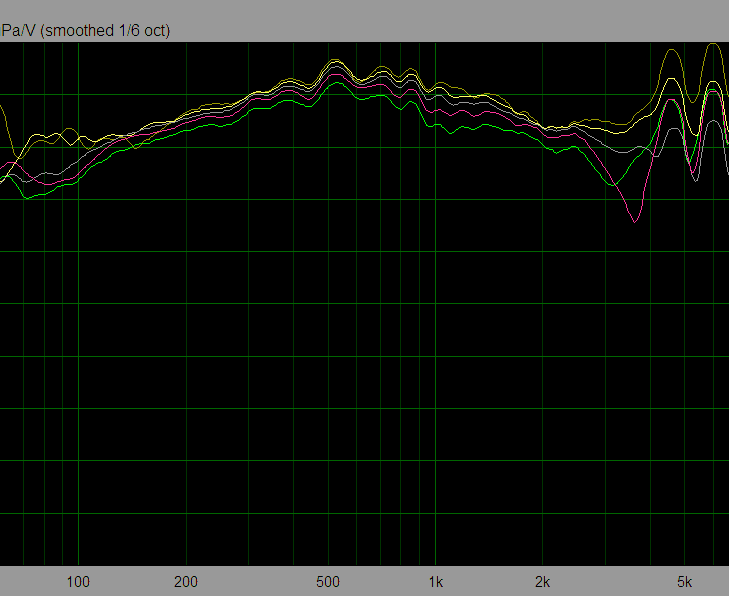
If we compare to Linkwitz Phoenix measurement, there are two differences. First, the polar response of the phoenix widens, then narrow, then widens again. This may be due to the resonant structures at the back (very complex splines). Second, the smoothness ends at 1.5kHz. But this doesn't matter as the phoenix is crossed at 1.4khz.
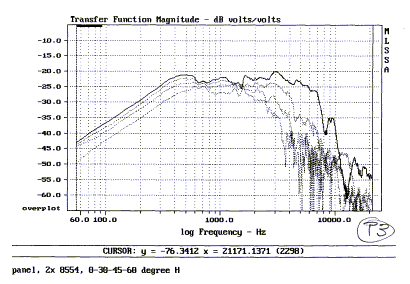
Overall, the S10 baffle-driver combination is smoother than Phoenix. I don't have measurement data for NaO or Orion but that would be interesting to look at as their baffles are as wide.

I've thought about 3-way, but with OB the complexity is exponential, not only the circuit/added amplifiere requirements but also acoustic such as the different physical baffle requirements.
The "peak" at 1.2khz is not actually a peak. The graph is differential graph so that peak refers to frequency response dropping more than they should compared to the lesser angles (The smaller P13, instead, have 1.5khz peak due to some energy storage issue as can be seen in the datasheet).
Below is a smoothed graph to lessen diffraction artefacts. Crossing the system at 1.5khz provides very smooth on and off-axis response. I could perhaps try to move up the frequency to 1.8khz to less strain the tweeter, but that metal resonance and harmonics would really show up.

If we compare to Linkwitz Phoenix measurement, there are two differences. First, the polar response of the phoenix widens, then narrow, then widens again. This may be due to the resonant structures at the back (very complex splines). Second, the smoothness ends at 1.5kHz. But this doesn't matter as the phoenix is crossed at 1.4khz.

Overall, the S10 baffle-driver combination is smoother than Phoenix. I don't have measurement data for NaO or Orion but that would be interesting to look at as their baffles are as wide.
Last edited:
...
The "peak" at 1.2khz is not actually a peak. The graph is differential graph so that peak refers to frequency response dropping more than they should compared to the lesser angles...
Nice work! I was a little confused too by the difference graph - in a difference graph, I would expect a drop at 1.2k at 60deg, looking at the original data. Doesn't matter though. Narrow baffles are good! Are the edges rounded over or any wings?
You know, looking again at your raw data (the first picture in post #21), at 2k, things really converge together - but I don't see that in the difference graph right below that. How did you calculate your difference graph?
Also, looking again at 1.2k (assuming each vertical division is 5dB), the 60deg response is down -12dB. Ideally at 60deg, OB should be down -6dB, so there is a -6dB error centered at 1.2k, but starts at about 800Hz, and ends at about 1.6k. This broad deviation isn't very obvious in your difference graph, maybe because of the manual offsets?
Anyway, I'm interested in how you calculated the difference graphs. Thanks!
Also, looking again at 1.2k (assuming each vertical division is 5dB), the 60deg response is down -12dB. Ideally at 60deg, OB should be down -6dB, so there is a -6dB error centered at 1.2k, but starts at about 800Hz, and ends at about 1.6k. This broad deviation isn't very obvious in your difference graph, maybe because of the manual offsets?
Anyway, I'm interested in how you calculated the difference graphs. Thanks!
Last edited:
The difference graph is calculated as follows:
0-20 = 0 deg value - 20 deg value
0-30 = 0 deg value - 30 deg value - 10 (this is to lower the line in the graph)
0-40 = 0 deg value - 40 deg value - 20
... and so on. So the way to read it is to look for deviations. At 1143 the first 3 lines are nearly equal so we can conclude that the off-axis response up to 40 deg is uniform. But at 60deg, there is more dip, thus not ideal.
Now look at 2625Hz, the lines are all over the place. Very bad. At 40 deg the response drops more than at 60deg.
These can be seen in the actual graph, just easier with the difference graph.
0-20 = 0 deg value - 20 deg value
0-30 = 0 deg value - 30 deg value - 10 (this is to lower the line in the graph)
0-40 = 0 deg value - 40 deg value - 20
... and so on. So the way to read it is to look for deviations. At 1143 the first 3 lines are nearly equal so we can conclude that the off-axis response up to 40 deg is uniform. But at 60deg, there is more dip, thus not ideal.
Now look at 2625Hz, the lines are all over the place. Very bad. At 40 deg the response drops more than at 60deg.
These can be seen in the actual graph, just easier with the difference graph.
Seas distortion
Seas L21RNXP distortion measurement is as follows. 2nd order distortion was successfully eliminated. That distortion would have been in 4500/2=2250Hz region. But 3rd, 4th, and 5th clearly appears at 1.5kHz, 1.2kHz, and 900Hz.
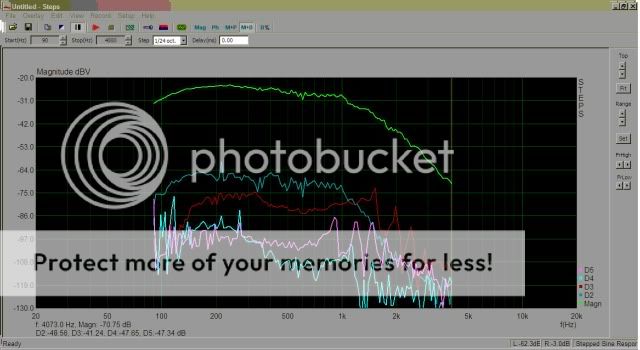
I've listened carefully with many different materials now, also did the "piano" test as suggested by Zaph. In either cases I could not identify these distortions. It's interesting because I can identify it with pink noise. Perhaps the pink noise excites more harmonics than normal music/steady state tests.
Seas L21RNXP distortion measurement is as follows. 2nd order distortion was successfully eliminated. That distortion would have been in 4500/2=2250Hz region. But 3rd, 4th, and 5th clearly appears at 1.5kHz, 1.2kHz, and 900Hz.

I've listened carefully with many different materials now, also did the "piano" test as suggested by Zaph. In either cases I could not identify these distortions. It's interesting because I can identify it with pink noise. Perhaps the pink noise excites more harmonics than normal music/steady state tests.
Thanks for showing your equation, it makes more sense now.
Supposedly, pink noise is more discriminating. Something I was doing the other day was listening to sine waves for distortion - sometimes I could definitely hear the higher harmonics. Comparing a cleanly working driver to one with higher HD, the 'dirty' one sounded gritty or rougher. I still don't know how audible it would be with music. I assume higher harmonics are inaudible if they are more than -60dB down, so your driver looks good to me. The other factor is how loud the driver is playing, but that gets more complicated.
Supposedly, pink noise is more discriminating. Something I was doing the other day was listening to sine waves for distortion - sometimes I could definitely hear the higher harmonics. Comparing a cleanly working driver to one with higher HD, the 'dirty' one sounded gritty or rougher. I still don't know how audible it would be with music. I assume higher harmonics are inaudible if they are more than -60dB down, so your driver looks good to me. The other factor is how loud the driver is playing, but that gets more complicated.
Conclusion
And now to conclude this project ...

Answering my own questions when it started a week ago:
- Ability of the midrange to cross lower than P13WH. Let's say 120Hz, presumably better integration with the woofers.
8" driver is able to cross lower. For L21 this is 130Hz, and the acoustic slope will match the electrical slope. If lower frequency is required then additional SLP filter is required at the first pole.
- Transparency of rigid cone drivers. Is the claims true?
Somewhat but difficult to tell if it is or it is not, comparing to P13WH. P13 is said to be one of the best midrange. When in doubt I'd say no. I wouldn't sweat to not using rigid piston driver and just rely on actual tests such as Zaph or linkwitz.
- Much higher SPL level
I feel the 8" is a bit effortless when played loud.
And some drawbacks I would expect/investigate:
- The need to cross the mid to tweeter lower, possibly straining the tweeter.
The K1 seems to be doing okay. In measurement the distortion rises but it's not audible. I haven't investigated how it will do on really high SPL such as 108dB the Orion spec'd at, my guess it will fall apart.
- Would the increase of baffle from 19cm to 24cm affect the polar response in a really bad way?
No, they are practically the same. I think it's more about driver/baffle ratio rather than absolute width.
- Metal cone resonance
Big YES. It shows up in measurement and pink noise, but not audible with music material.
Overall the S10 is still a very cheap system. It achives smooth, uniform power response across wide frequency range and is very satisfying to listen to. It is something that the majority of speakers, box especially, would never achieve.
An interesting finding here is as long as the OB design goal is reached, no matter the smaller build details (driver type, xo points, notch difference, etc), the speakers would sound similar.
Further improvements I think will be around the drivers themselves, not 'sonically' perhaps but SPL and linear operating limits. In terms of value if I had to start all over again I would go with that $39 Zaph woofers and those $13 Vifa titanium tweeters. At less than $200 that would make an extremely high-value system.
Thanks for all the feedback given. This is a really fulfilling hobby !
And now to conclude this project ...

Answering my own questions when it started a week ago:
- Ability of the midrange to cross lower than P13WH. Let's say 120Hz, presumably better integration with the woofers.
8" driver is able to cross lower. For L21 this is 130Hz, and the acoustic slope will match the electrical slope. If lower frequency is required then additional SLP filter is required at the first pole.
- Transparency of rigid cone drivers. Is the claims true?
Somewhat but difficult to tell if it is or it is not, comparing to P13WH. P13 is said to be one of the best midrange. When in doubt I'd say no. I wouldn't sweat to not using rigid piston driver and just rely on actual tests such as Zaph or linkwitz.
- Much higher SPL level
I feel the 8" is a bit effortless when played loud.
And some drawbacks I would expect/investigate:
- The need to cross the mid to tweeter lower, possibly straining the tweeter.
The K1 seems to be doing okay. In measurement the distortion rises but it's not audible. I haven't investigated how it will do on really high SPL such as 108dB the Orion spec'd at, my guess it will fall apart.
- Would the increase of baffle from 19cm to 24cm affect the polar response in a really bad way?
No, they are practically the same. I think it's more about driver/baffle ratio rather than absolute width.
- Metal cone resonance
Big YES. It shows up in measurement and pink noise, but not audible with music material.
Overall the S10 is still a very cheap system. It achives smooth, uniform power response across wide frequency range and is very satisfying to listen to. It is something that the majority of speakers, box especially, would never achieve.
An interesting finding here is as long as the OB design goal is reached, no matter the smaller build details (driver type, xo points, notch difference, etc), the speakers would sound similar.
Further improvements I think will be around the drivers themselves, not 'sonically' perhaps but SPL and linear operating limits. In terms of value if I had to start all over again I would go with that $39 Zaph woofers and those $13 Vifa titanium tweeters. At less than $200 that would make an extremely high-value system.
Thanks for all the feedback given. This is a really fulfilling hobby !

.oOo.
Last edited:
It is funny how with each iteration you get closer and closer to Orion ... in fact if you made your baffles a tad wider (or angle woofers a bit to fit) you could place them under and presto - Orions on the cheap !
Great journey, I'm jealous ! Any chance of demoing them one day ?
Bratislav
Great journey, I'm jealous ! Any chance of demoing them one day ?
Bratislav
It is funny how with each iteration you get closer and closer to Orion ... in fact if you made your baffles a tad wider (or angle woofers a bit to fit) you could place them under and presto - Orions on the cheap !
Great journey, I'm jealous ! Any chance of demoing them one day ?
Bratislav
I kind of stuck with cd mid tweets/ dipole bass for a long time, made (for me) a difficult planar stand mount with a tuned chamber (Neo 10 mid bass needs reinforcing)that double dutied as a 400 hz transmission line, along with a rear 4" port to provide some dipole radiation . The BG neo 3 made dipole treble very easy.
Now I've gone as simple as I can; a vintage SEAS tv21 mounted off centre in a variably tilting 19mm disk, below a 7.5" planar tweeter from a cancelled project.
The tweeter amp is hi passed at line level with a tiny cap, the mid woof amp highpassed with a larger nos teflon cap, also at line level.
Deep bass supplied from an old push pull sub setup.
The idea was to conserve tube watts and minimize parts count in the signal path.
Basically aiming the beaming frequencies of that 8" seas in a snooker shot off the ceiling and behind my listening position, and adjusting the angle to get a decent blend with my tweeters.
Seems like a simple design like this gets more stuff right than my more elaborate and difficult (costly in time and $) projects.
Sometimes inspiration can beat perspiration.
It's always a process; hopefully we get better...
It is funny how with each iteration you get closer and closer to Orion ... in fact if you made your baffles a tad wider (or angle woofers a bit to fit) you could place them under and presto - Orions on the cheap !
Great journey, I'm jealous ! Any chance of demoing them one day ?
Bratislav
Still travelling, used a Taiwan 4" whizzer cone full ranger as a tweeter with the SEAS tv21 , same configuration; very very good, even if it looks laughable, but everything's dipole but the bass.
Still travelling, used a Taiwan 4" whizzer cone full ranger as a tweeter with the SEAS tv21 , same configuration; very very good, even if it looks laughable, but everything's dipole but the bass.
Sorry, but we should be careful with the term "dipole". An open back configuration does not radiate in dipole pattern throughout it's range. This problem was discussed earlier in this thread, and "evolution" has lead to 4-way dipoles. Still the geometry/physics give us trouble in the tweeter range.
Sorry, but we should be careful with the term "dipole". An open back configuration does not radiate in dipole pattern throughout it's range. This problem was discussed earlier in this thread, and "evolution" has lead to 4-way dipoles. Still the geometry/physics give us trouble in the tweeter range.
Thanks for the heads up. I will read up on this.
- Status
- This old topic is closed. If you want to reopen this topic, contact a moderator using the "Report Post" button.
- Home
- Loudspeakers
- Multi-Way
- S10 OB - Seas L21RNXP on Open Baffle